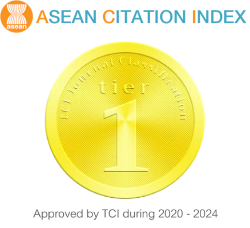การส่งเสริมการเดินและใช้จักรยานในชีวิตประจำวัน: กรณีศึกษา 4 ชุมชนในประเทศไทย
คำสำคัญ:
การเดิน, การใช้จักรยาน, กิจกรรมทางกาย, ชุมชน, นโยบายบทคัดย่อ
การเดินและการใช้จักรยานเป็นกิจกรรมทางกายรูปแบบหนึ่งที่ประชาชนสามารถทำได้อย่างสม่ำเสมอในชีวิตประจำวัน ซึ่งส่งผลดีต่อสุขภาพ สิ่งแวดล้อมและเศรษฐกิจ การศึกษานี้ มีวัตถุประสงค์เพื่อ 1) ประเมินกระบวนการดำเนินงานส่งเสริมการเดินและใช้จักรยานโดยภาคีต่างๆ ในชุมชน 2) ประเมินช่องว่างการดำเนินงานส่งเสริมการเดินและใช้จักรยานในชุมชน และ 3) เสนอแนะแนวทางการส่งเสริมการเดินและใช้จักรยานในชุมชน ผู้วิจัยได้ใช้กระบวนการวิจัยเชิงคุณภาพ วิธีการเก็บข้อมูลคือการสัมภาษณ์เชิงลึกผู้เกี่ยวข้องในการบริหารจัดการส่งเสริมการเดินและใช้จักรยาน จำนวน 28 คน ใน 4 ชุมชน 4 ภูมิภาค คือ 1) ชุมชนสมเด็จพระเจ้าตากสิน อ.บางคล้า จ.ฉะเชิงเทรา 2) ชุมชนสุขสบายใจ อ.เมือง จ.กาฬสินธุ์ 3) ชุมชนโรงเรียนเทศบาลบ้านเขานิเวศน์ อ.เมือง จ.ระนอง และ 4) ชุมชนบ้านธาตุสบแวน อ.เชียงคำ จ.พะเยา การวิเคราะห์ข้อมูลใช้วิธีวิเคราะห์เนื้อหา ผลการศึกษาพบว่า ภาคีหลักในการส่งเสริมการเดินและการใช้จักรยานในชีวิตประจำวันมี 3 กลุ่ม ได้แก่ หน่วยงานราชการ ประชาสังคม และวิชาการ โดยมีบทบาทและกลไกการดำเนินงานที่แตกต่างกัน แต่เชื่อมโยงประสานกันเพื่อบรรลุวัตถุประสงค์ร่วมกัน ช่องว่างและความท้าทายในการดำเนินงาน คือ ทัศนคติเชิงลบต่อการเดินและการใช้จักรยาน และปัญหาด้านสภาพแวดล้อมทางกายภาพที่ไม่เหมาะสมหรือไม่ปลอดภัย ข้อเสนอแนะในการดำเนินงานต่อ คือ การสื่อสารให้เกิดค่านิยมเชิงบวก ปรับปรุงสภาพแวดล้อมทางกายภาพโดยเฉพาะการลดความเร็วของยานพาหนะในชุมชน และการมีนโยบายสนับสนุนการเดินและการใช้จักรยานในชีวิตประจำวันที่เหมาะสมกับบริบทของพื้นที่
เอกสารอ้างอิง
Lee IM, Shiroma EJ, Lobelo F, Puska P, Blair SN, Katzmarzyk PT, et al. Effect of physical inactivity on major non-communicable diseases worldwide: an analysis of burden of disease and life expectancy. Lancet 2012;380(9838):219-29.
World Health Organization. Global health risks: mortality and burden of disease attributable to selected major risks. Geneva: World Health Organization; 2009.
World Health Organization. Global health observatory data: prevalence of insufficient physical activity. Geneva: World Health Organization; 2016 [cited 2019 Oct 7]. Available from: https://www.who.int/gho/ncd/risk_factors/physical_activity_text/en/.
Ketwongsa P. National physical activity survey 2011-2016. Nakornpathom: Institute for Population and Social Research, Mahidol University; 2016.
Burden of Disease Thailand, IHPP. Thailand burden of diseases attributable to risk factors 2014. Bangkok: Burden of Disease Thailand, International Health Policy Program; 2018.
Gerike R, de Nazelle A, Nieuwenhuijsen M, Panis LI, Anaya E, Avila-Palencia I, et al. Physical activity through sustainable transport approaches (PASTA): a study protocol for a multicentre project. BMJ Open 2016;6(1):e009924.
Koszowski C, Gerike R, Hubrich S, Götschi T, Pohle M, Wittwer R. Active mobility: bringing together transport planning, urban planning, and public health: challenges, solutions and collaborations. In: Beate Müller, Gereon Meyer, editors. Towards user-centric transport in Europe: challenges, solutions and collaborations. Cham: Springer International Publishing; 2019. p. 149-71.
Sahlqvist S, Song Y, Ogilvie D. Is active travel associated with greater physical activity? The contribution of commuting and non-commuting active travel to total physical activity in adults. Prev Med 2012;55(3):206-11.
Topothai T, Topothai C, Phonguttha S, Suriyawongpisarn W, Chandrasiri O, Thamarangsi T. The daily energy expenditure of 4 domains of physical activity of Thai adults. Journal of Health Systems Research 2015;9(2):168-80.
Topothai T, Liangruenrom N, Topothai C, Suriyawongpisarn W, Limwattananon S, Limwattananon C, et al. How much of energy expenditure from physical activity and sedentary behavior of Thai adults: the 2015 national health and welfare survey. Journal of Health Systems Research 2017;11(3):327-44.
Woodcock J, Edwards P, Tonne C, Armstrong BG, Ashiru O, Banister D, et al. Public health benefits of strategies to reduce greenhouse-gas emissions: urban land transport. Lancet 2009;374(9705):1930-43.
Thailand Walking and Cycling Institute Foundation. The 7th Thailand Bike and Walk Forum 2019: think globally, bike-walk locally. Bangkok: Thailand Walking and Cycling Institute Foundation; 2019.
Wasi P. “Triangle That Moves The Mountain” and health systems reform movement in Thailand. Human Resources for Health Development 2000;4(2):106-10.
Zwald ML, Eyler AA, Goins KV, Brownson RC, Schmid TL, Lemon SC. Understanding municipal officials’ involvement in transportation policies supportive of walking and bicycling. J Public Health Manag Pract 2017;23(4):348-55.
Dodson EA, Langston M, Cardick LC, Johnson N, Clayton P, Brownson RC. “Everyone should be able to choose how they get around”: how Topeka, Kansas, passed a complete streets resolution. Prev Chronic Dis 2014;11:E25.
Larouche R, Barnes J, Tremblay MS. Too far to walk or bike? Can J Public Health 2013;104(7):e487-9.
Timperio A, Ball K, Salmon J, Roberts R, Giles-Corti B, Simmons D, et al. Personal, family, social, and environmental correlates of active commuting to school. Am J Prev Med 2006;30(1):45-51.
Bangkhla Subdistrict Municipality. Community development plan (2018-2022). Bangkhla: Bangkhla Subdistrict Municipality; 2018.
Bangkhla Subdistrict Municipality. Community development plan (2018-2022), revised 1/2019. Bangkhla: Bangkhla Subdistrict Municipality; 2019.
Chiangkam Subdistrict Municipality. Community action plan 2020. Chiangkam: Chiangkam Subdistrict Municipality; 2019.
Kalasin Town Municipality. Community development plan (2018-2022). Kalasin: Kalasin Town Municipality; 2018.
Kalasin City Municipality. Community development plan (2018-2022), revised 1/2019. Kalasin: Kalasin City Municipality; 2019.
Ranong Town Municipality. Community development plan (2018-2022). Ranong: Ranong Town Municipality; 2017.
Piriyawat S. Explaining traveler’s intention towards bicycle usages in daily life by using model of goal directed behavior theory: Bangkhla, Chachoengsao Case Study. Chonburi: 2018.
Piriyawat S. Investigating problems and obstructions on bicycle usages in daily life and policy processes for overcoming the problems: Bangkhla, Chachoengsao case study. Chonburi: 2019.
Wises S. The creation on walk and bike friendly community for every day life in Youn and Chiang Kam subdistrict, Chiang Kam district, Phayao province. Phayao: 2018.
Wises S. Walking and biking promotion for cultural toursim in Chiang Kam district, Phayao province. Phayao: 2019.
Topothai T, Topothai C, Suphanchaimat R, Chandrasiri O, Sukaew T, Putthasri W, et al. The promotion of walking and biking for transportation, and public transport using: a case study in four communities in Thailand. Nonthaburi: International Health Policy Program; 2020.
Topothai T, Topothai C, Suphanchaimat R, Chandrasiri O, Sukaew T, Tangcharoensatien V, et al. Physical activity, carbon dioxide emission and cost of transport: a case study of three communities in Thailand. Journal of Health Systems Research. 2020;14(4):458-77.
Bopp M, Sims D, Piatkowski D. Bicycling for transportation. United States: Elsevier Science Publishing; 2018.
Vuori I. Promoting cycling: a review of interventions. Clin J Sport Med 2011;21(6):542-4.
Yang Y, Ivey SS, Levy MC, Royne MB, Klesges LM. Active travel to school: findings from the survey of US health behavior in school-aged children, 2009-2010. J Sch Health 2016;86(6):464-71.
Hess G, Peterson MN. “Bicycles May Use Full Lane” Signage Communicates U.S. Roadway Rules and increases perception of safety. PLoS One 2015;10(8):e0136973.
Rissel CE, New C, Wen LM, Merom D, Bauman AE, Garrard J. The effectiveness of community-based cycling promotion: findings from the Cycling Connecting Communities project in Sydney, Australia. Int J Behav Nutr Phys Act 2010;7(1):8.
ดาวน์โหลด
เผยแพร่แล้ว
รูปแบบการอ้างอิง
ฉบับ
ประเภทบทความ
สัญญาอนุญาต

อนุญาตภายใต้เงื่อนไข Creative Commons Attribution-NonCommercial-NoDerivatives 4.0 International License.
วารสารวิจัยระบบสาธารณสุขอยู่ภายใต้การอนุญาต Creative Commons Attribution-NonCommercial-NoDerivatives 4.0 International (CC BY-NC-ND 4.0) เว้นแต่จะระบุไว้เป็นอย่างอื่น




